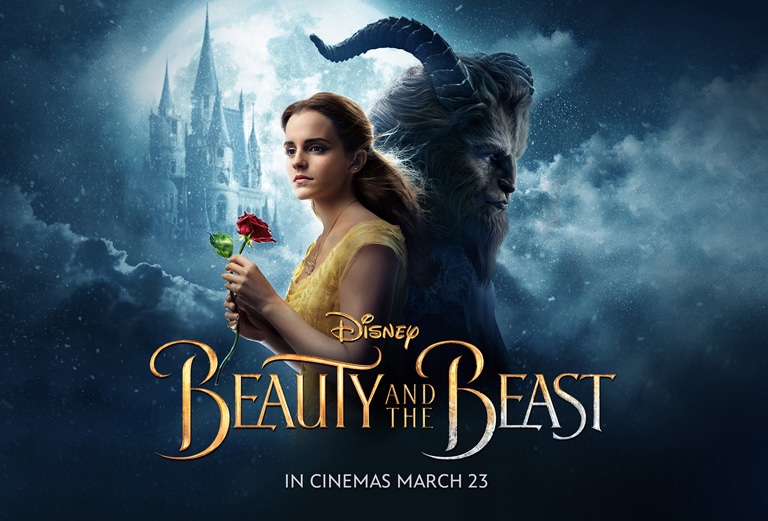He was a handsome young prince living in a beautiful castle, and—like all charming men of royalty—many women flocked to him.
But as good-looking as he was on the outside, he was dark and hideous on the inside. He taxed the villagers so he could acquire nice things, and he teased the women with no desire to settle down. Then one night, as he danced from partner to partner in the ballroom, an elderly woman came begging, simply wanting shelter from the rain. Yet he ordered her to leave, repulsed by her appearance.
This woman, though, was no ordinary vagabond. She was a beautiful enchantress who cast a spell on him and the castle, turning him into a beast and his home into a dreadful-looking filthy fortress. As the narrator tells us, “she had seen there was no love in his heart.”
The only way he can change back to a prince is by finding a woman who will love him—a seemingly impossible task for a horned creature filled with hate.
Disney’s Beauty and the Beast (PG) opens this weekend, giving us a live-action remake of the studio’s 1991 animated hit that was the third-highest grossing movie that year. The 2017 version stars Emma Watson as Belle, Dan Stevens as the Beast, and Luke Evans as the vain and annoying Gaston, who has his eyes on Belle. The film was directed by Bill Condon.
It’s a story that is packed with wonderful (even biblical) lessons for kids of all ages—beauty is found on the inside, and arrogance has a price—but this remake comes with some modern-day baggage. For the first time, Disney has introduced an openly (and obvious) gay character in a children’s film—LeFou (Josh Gad), who is Gaston’s servant. For many families, it will stain what otherwise is a marvelous, instant classic.
So, just how overt are the gay moments? And is Beauty and the Beast OK for children? Let’s take a look.
The Good
Setting aside the controversy for the moment, Beauty and the Beast is marvelous. Its music easily surpasses that of the 1991 version; its dance numbers are fun; and the film’s visuals—the flower-filled hills of Belle’s village countryside and the snow-packed landscape of the Beast’s home—are stunning. No doubt, many will leave the theater and download the soundtrack.
It’s also very funny, led by the back-and-forth between the teacup and mantel clock.
The story’s message about the true definition of beauty dominates the film. The narrator tells us in the opening scene that “beauty is found within,” and later Belle repeats a line from Shakespeare: “Love looks not with the eyes but with the mind.” (More on this in “The Worldview” section below.)
Scripture tells us that pride comes before destruction (Proverbs 16:18), and Beauty and the Beast affirms that truth. The prince’s arrogance results in him being turned into a creature, and Gaston’s pride prevents him from winning Belle. It is only when the Beast learns to place himself second that she falls for him.
By contrast, Belle is humble. When her father is placed in the Beast’s prison early in the film, she sacrifices her safety by trading spots with him, against his will. Later, when Beast saves her from a pack of wolves and is left beaten and bloodied, she opts against an escape and instead takes him back to his castle where she nurses him to health.
Finally, the film provides children a good message that it’s OK to be different. The townspeople label the bookworm Belle a “peculiar” girl who is “nothing like the rest of us,” but she refuses to change, knowing that there is nothing wrong with an educated woman.
The Bad
The film has no coarse language. Beast does reference “eternal damnation” and being “damned” for eternity, but the words are used in their original sense.
It has a moderate amount of violence. Gaston punches another man and fights Beast. Gaston also shoots someone. The villagers rush the castle and try to find Beast, but the teacup and others discover unique ways to stop them.
There is no sensuality and only two or three kisses.
LeFou’s homosexuality is the primary concern. I walked into the theater wondering if the controversy was much ado about nothing, and walked out believing it was well deserved. No, the word “gay” is not in the film, and LeFou and Gaston never kiss, but it is obvious from the get-go that he is not straight.
I counted five gay moments: 1) As Gaston gazes at Belle through a scope, LeFou responds, “Who needs her when you’ve got us?” 2) When Gaston chases women in the town square, LeFou follows him around, making clear that it’s not just the females who like him. 3) As Gaston sits in an armchair in a tavern, LeFou leans toward him seductively, although Gaston doesn’t notice. He also briefly gives Gaston a massage. 4) When the people in the tavern start singing and dancing about Gaston’s superiority, LeFou spins and suddenly finds himself being held from behind by Gaston. LeFou says, “Too much?” Gaston responds, “Yes.” 5) In the movie’s final big dance number, LeFou is partnered with a man—a man who just moments earlier was enjoying wearing women’s clothes. Each of those latter two scenes lasts only a couple of seconds, but Disney’s message is clear: LeFou has found his man. Overall, it detracts from the main story.
Now for the question that many parents are asking: Will children even notice all of this? Some won’t. (He is, after all, a secondary character.) But other children, particularly older ones, will. Cartoons in the past have showed men dancing together or even hugging, but it was laughed off or treated as a mistake. Yet LeFou enjoys the contact. He also is effeminate for much of the film (although not in every scene).
This Hollywood trend is touching every aspect of entertainment. 24: Legend has a gay angle. Downton Abbey did, too. Even a Nickelodeon cartoon has featured two dads. Disney even included a scene with several same-gender couples kissing in the Feb. 27 episode of the children’s cartoon “Star vs. the Forces of Evil,” available on the Disney XD network website.
Sadly, families are being forced to discuss an issue they’d rather save for later, when the kids are more mature.
It doesn’t even matter if parents take the kids to watch Beauty and the Beast. Their friends will see it. And the kids will come home with questions. We better be ready with answers.
The Worldview
It is sad that Disney chose to make Gaston’s sidekick gay. That’s because this film has a message about beauty that all of our children—particularly our girls—need to hear. It is this: True beauty has nothing to do with physical looks. The Bible tells us that beauty, as the world sees it, is “fleeting” (Proverbs 31:30) and that God “looks at the heart” (1 Samuel 16:7). I tell my young daughter that the definition of beauty is “to love God and to love others.”
In the film, a girl who could have married any man in town instead falls for a ghastly Beast because, as Belle sings, “There is something in him I did not see.” What a story! Tragically, though, many Hollywood films preach exactly the opposite message.
The Verdict: OK for Kids & Teens?
Beauty and the Beast is certainly scarier than the 1991 cartoon version, although filmmakers seemed to have gone to great lengths to keep it in PG territory. Comparing it to recent kids’ films, it’s as scary as The BFG and The Jungle Book. There are several intense scenes, including two involving packs of wolves trying to catch people. The final fight scene between Gaston and the Beast also is a bit frightening.
But the LeFou controversy is the sole focus on many traditional families. If not for it, I likely would take my 5-year-old daughter to see it. Now, we may just wait for the DVD.
Discussion Questions
What is beauty? How does the world’s definition differ from the biblical definition? Does God care about physical beauty? What does it mean to be arrogant? How can we fight arrogance and pride? What made Belle change her mind about the Beast? Why didn’t Belle want to marry Gaston? Which characters exhibited grace? Which characters exhibited humility? What does Scripture say about homosexuality? How can we tackle this issue with grace, while standing for truth?
Beauty and the Beast is rated PG for some action violence, peril and frightening images.
Entertainment rating: 4 out of 5 stars. Family-friendly rating: 2.5 out of 5 stars.














